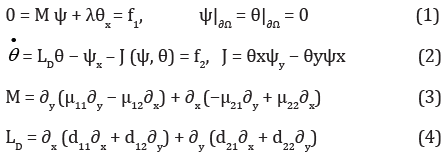Authored by Abdelhafez MA
Based on the Darcy model, fluid convection in a porous rectangle is analyzed taking into account anisotropy of thermal characteristics and permeability. Relations between parameters for which the problem belongs to the class of co-sssymmetric systems are derived. For this case explicit formulas for the critical numbers of the loss of stability of mechanical equilibrium are found. Using a finite-difference method that preserves the cosymmetry of the problem, family of stationary convective regimes is computed. Through the computational experiment the destruction of families is demonstrated in the case of violation of the conditions of co-symmetry. As result the appearance of a finite number of stationary regimes are obtained.
The plane problem of heating a rectangular container is considered Ω = [0, a] × [0, b], on the boundary of which the conditions of impermeability and temperature pro le linear in height are given T∗(y) = T2 − y(T2 − T1)/b, Where T1 И T2 temperature at the top (y = b) and bottom (y = 0) boundaries, respectively, the force of gravity acts in the direction opposite to the coordinate y. Next, a perturbation of the temperature field is introduced T (x, y, t) = T∗(y) + θ (x, y, t) and a transition is made to dimensionless quantities [1]. For stream function ψ and temperature deviations θ the following initial-boundary problem is obtained with respect to the linear profile:

Equations (1)-(4) supplemented with initial conditions θ (x, y, 0) = θ0(0, y).
With μ11 = μ22 = d11 = d22 = 1 И μ12 = μ21 = d12 = d21 = 0 from (1)-(2) equations are obtained that correspond to the isotropic problem. In this case, the system of equations is co-symmetric according to [2], those there is a vector field L, which is orthogonal to the vector field of the problem and does not vanish on a nontrivial stationary solution. IN [1] set the conditions under which the task (1)-(4) is cosymmetric, these conditions are clarified by the following lemma.
Lemma
Under the conditions
Mechanical Equilibrium Stability Analysis
Equations (1)-(4) satisfies zero solution θ = ψ = 0, corresponding to mechanical equilibrium. In the case of μ12 = μ21 = d12 = d21 = 0 from (1)-(4) for perturbations, a linear system is obtained

In case of violation of conditions (5) vector function L = (d22θ, -μ11ψ) is not a problem co-symmetry. In this case, instead of a oneparameter family, a finite number of convective regimes are formed. (stationary or non-stationary) [3-5].
Further numerical research is carried out for the case μij = dij = 0, (i ≠ j). Following [3], it turns out selective (selection) function


Numerical Study
In the case of anisotropy, the Darcy problem with co-symmetry in the [1] an analysis of the occurrence of stationary convective regimes, branching o from the loss of stability of mechanical equilibrium, is given. The conditions on the coefficients of the system under which the problem has co-symmetry and the branching of the continuous family of stationary modes are analytically determined. In this paper, the results of calculations of the families themselves are presented on the basis of the scheme [6], and the study of their destruction under violation of the conditions. Table 1 presents the results of calculations of the critical Rayleigh numbers depending on combinations of parameters of reverse permeability μii and thermal conductivity d22 ΠpИ d11 = 1, a = 2.5, b = 1. The value λ11, λ21 is calculated by the formula (8), and the quantities λh1 , λh2 , λh3 h meet the first three critical values on the grid 36 × 12. In the last column ⪡KOC⪢ notes the fulfillment of the conditions of co-symmetry (5).To read more about this article...Open access Journal of Engineering Sciences
Please follow the URL to access more information about this article
https://irispublishers.com/gjes/fulltext/darcy-convection-anisotropic-problem-with-multi-stability-of-stationary-motions-for-rectangle.ID.000542.php
To know more about our Journals... Iris Publishers
To know about Open Access publisher




No comments:
Post a Comment